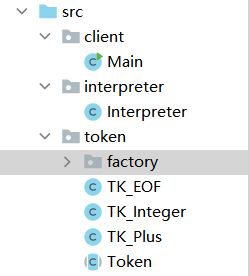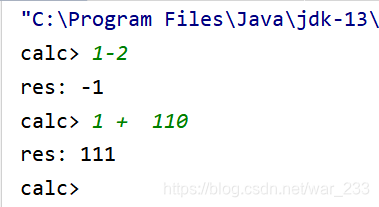手写Pascal解释器(一)
一、编写解释器的动机#
学习了Vue之后,我发现对字符串的处理对于编写一个程序框架来说是非常重要的,就拿Vue来说,我们使用该框架时可以通过如v-on:, v-model等html的属性时,我们能够在里面嵌入js代码,其实这块就已经使用了编译原理的知识来对输入的字符串进行解析,然后将它们嵌入到js代码中去,这也是我们在Vue中可以如此轻松地进行双向绑定,使用v-for进行列表渲染等等的技术基础。此外在做ccf csp的题目时,我也往往被一些字符串处理的题目给卡住,有时候虽然可以做出来,但有种只见树木不见森林之感。所以我希望可以快点先学习到一些编译原理的知识(而且自学往往比上课学习的效率和积极性高得多),为后面的学习打个基础。
至于为什么学习编译原理先学习编写解释器呢?之前我是直接啃“龙书”(《compiler》)来着,可是里面真的许多东西比较晦涩难懂,之后我先去逛下知乎看看大神们是怎么学习编译原理的,看到有位大佬说可以多抄几遍这个解释器项目,很多东西自然就理解了:学习编译原理有什么好的书籍? - 时雨的回答 - 知乎。然后我就点进去那个GitHub项目的链接,发现居然star数高达1.3k:

于是我决定先通过它来进行学习了。
二、part1#
(补上gitee项目地址,欢迎clone项目:https://gitee.com/warrior__night/learn-writing-interpreter)
资料链接:https://ruslanspivak.com/lsbasi-part1/
part1的任务比较简单,它需要输入一个带有两个操作数的字符串,且只支持“+”号,如输入“1+2”,它会输出“3”。
项目的源码是使用python编写的,而我为了印象深刻些(也防止自己不加思考嗯抄),就使用java进行重新编写了。

编写了这样几个类,由于java是半静态语言,故各个Token都使用类来进行封装了(如TK_Interger,即为整形数字,继承自Token类,其他的类似),使用起来比较方便一些。
主要的类为Interpreter类,重点解读一些Interpreter类干了什么事:
类的成员变量:
private final String text;
private int pos;
private Token currentToken;
text是输入的表达式字符串,pos是当前指向哪个位置的字符,currentToken是当前的Token是什么。
构造函数:
public Interpreter(String text){
this.text = text;
this.pos = 0;
this.currentToken = null;
}
接收一个表达式字符串,其他的变量都清零
抛出异常函数:
public void error() throws Exception {
throw new Exception("Error parsing input");
}
当输入不符合当前规则时抛出“Error parsing input”异常
获取下一个Token的函数getNextToken:
public Token getNextToken() throws Exception {
// 如果下标到了字符串的尽头,则返回TK_EOF
if (pos > text.length()-1){
return new TK_EOF();
}
char currentChar = text.charAt(pos);
// 如果是数字,则返回TK_Interger(即数字Token),由于part1只考虑一个数字的情况,故只需解析一个数字
if (Character.isDigit(currentChar)){
Token token = new TK_Integer(Integer.parseInt(currentChar+""));
// 指针移动到读取完Token的位置
pos++;
return token;
}
// 解析符号也是相同的过程
if (currentChar == '+'){
Token token = new TK_Plus();
pos++;
return token;
}
// 如果不是数字或者“+”,则抛出异常
this.error();
return null;
}
eat函数:
public void eat(Token.TokenType tokenType) throws Exception {
if (currentToken.type == tokenType){
currentToken = getNextToken();
}
else {
this.error();
}
}
判断当前读取到的Token和预想的是不是一样的类型,然后读取下一个Token。
完成整个解析过程的函数:
public int expr() throws Exception {
currentToken = getNextToken();
// 第一个数
Token left = currentToken;
// 查看第一个Token是否是数字,并读取下一个Token
eat(Token.TokenType.INTEGER);
// 查看这个Token是否是“+”
eat(Token.TokenType.PLUS);
// 第二个数
Token right = currentToken;
// 查看第二个Token是否是数字,并读取下一个Token
eat(Token.TokenType.INTEGER);
// 最后返回运算结果
return (Integer)left.value + (Integer)right.value;
}
客户端类Main:
public class Main {
public static void main(String[] args) throws Exception {
Scanner scanner = new Scanner(System.in);
while (true){
System.out.print("calc> ");
String text = scanner.nextLine();
if (text.equals("exit"))
break;
Interpreter interpreter = new Interpreter(text); <--使用解释器进行解释
int res = interpreter.expr();
System.out.println("res: "+res);
}
}
}
运行结果:

运行结果符合预期,part1搞定!
三、part2#
资料链接:https://ruslanspivak.com/lsbasi-part2/
part2相较于part1增加了“-”(减法)的支持,然后可以跳过表达式中间的空格。
增加的函数或修改:
成员变量添加currentChar,代表当前指针指向的字符:
...
private Character currentChar;
构造函数添加currentChar的初始化:
public Interpreter(String text){
...
this.currentChar = text.charAt(pos);
}
添加指针向前的函数advance():
private void advance(){
pos++;
if (pos>text.length()-1){
this.currentChar = null;
}
else {
this.currentChar = text.charAt(pos);
}
}
添加跳过空格函数:
private void skipWhitespace(){
while (this.currentChar!=null && this.currentChar==' '){
this.advance();
}
}
读取整形数字函数:
private int integer(){
StringBuilder sb = new StringBuilder();
while (currentChar!=null && Character.isDigit(currentChar)){
sb.append(currentChar);
this.advance();
}
return Integer.parseInt(sb.toString());
}
有了这个函数,我们就可以读出多位的数字了。
修改getNextToken()函数:
private Token getNextToken() throws Exception {
while (currentChar != null){
// 如果是空格则直接跳过
if (this.currentChar == ' '){
this.skipWhitespace();
continue;
}
// 如果是数字则交给integer函数读取处理
if (Character.isDigit(currentChar)){
return new TK_Integer(this.integer());
}
// 如果是“+”或者“-”则返回TK_Plus和TK_Minus
if (currentChar=='+'){
this.advance();
return new TK_Plus();
}
if (currentChar=='-'){
this.advance();
return new TK_Minus();
}
// 如果是其他情况则抛出异常
this.error();
}
// 如果为currentChar空则返回TK_EOF
return new TK_EOF();
}
修改expr函数:
public int expr() throws Exception {
currentToken = getNextToken();
Token left = currentToken;
eat(Token.TokenType.INTEGER);
Token op = currentToken;
if (op.type == Token.TokenType.PLUS)
eat(Token.TokenType.PLUS);
else
eat(Token.TokenType.MINUS);
Token right = currentToken;
eat(Token.TokenType.INTEGER);
if (op.type == Token.TokenType.PLUS)
return (Integer)left.value + (Integer)right.value;
else
return (Integer)left.value - (Integer)right.value;
}
和part1的基本相同,这里不再赘述。
运行结果:

四、part3#
资料链接:https://ruslanspivak.com/lsbasi-part3/
以下图片为大佬博客翻译的内容:


part3的任务是可以解析多个操作数的加减运算,如“1+2 -3 +4”等。
添加或修改的部分:
添加term()函数:
public int term() throws Exception {
Token token = currentToken;
this.eat(Token.TokenType.INTEGER);
return (Integer) token.value;
}
其实就是eat+返回int的值
修改expr函数:
public int expr() throws Exception {
currentToken = getNextToken();
// 获取当前Token的值并移动指针
int result = this.term();
while (currentToken.type == Token.TokenType.PLUS || currentToken.type== Token.TokenType.MINUS){
Token token = currentToken;
if (token.type== Token.TokenType.PLUS){
// 判断并移动
eat(Token.TokenType.PLUS);
// 加上下一个数并移动指针
result+=term();
}
else{
// 解析同上
eat(Token.TokenType.MINUS);
result-=term();
}
}
return result;
}
运行结果:

下一篇:手写Pascal解释器(二)




【推荐】国内首个AI IDE,深度理解中文开发场景,立即下载体验Trae
【推荐】编程新体验,更懂你的AI,立即体验豆包MarsCode编程助手
【推荐】抖音旗下AI助手豆包,你的智能百科全书,全免费不限次数
【推荐】轻量又高性能的 SSH 工具 IShell:AI 加持,快人一步
· Linux系列:如何用 C#调用 C方法造成内存泄露
· AI与.NET技术实操系列(二):开始使用ML.NET
· 记一次.NET内存居高不下排查解决与启示
· 探究高空视频全景AR技术的实现原理
· 理解Rust引用及其生命周期标识(上)
· DeepSeek 开源周回顾「GitHub 热点速览」
· 物流快递公司核心技术能力-地址解析分单基础技术分享
· .NET 10首个预览版发布:重大改进与新特性概览!
· AI与.NET技术实操系列(二):开始使用ML.NET
· 单线程的Redis速度为什么快?